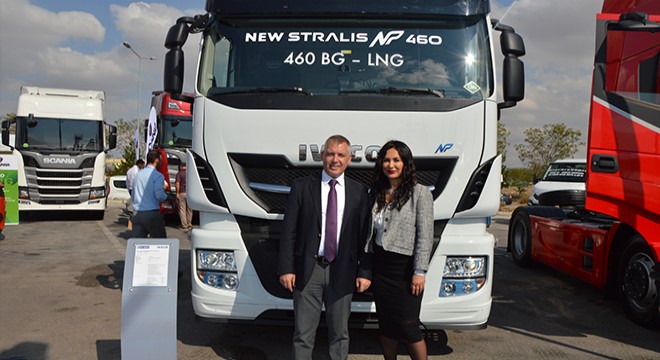
IVECO Heavy-Duty Vehicle Turkey Sales Manager Hakkı Işınak has stated that LNG-powered vehicles will be very popular in the domestic market and shared the details about the vehicles as well as their experiences with the demo vehicles with MY TRUCK Magazine.
LNG Can Increase the Range
The most attractive among the vehicles on display was IVECO's LNG-powered vehicles that is launched with its new NP Stralis model. You've launched the vehicle in August and we had a chance to take a closer look at that event. Can you share the details about the vehicle once again?
The vehicle was manufactured based on the Stralis line-up's platform; however, it has a completely new and unique engine and fuel technology. It has two fuel tanks. The tanks have a much more different system than those used on diesel and fuel oil tanks. They have three layers with special protections in place. They can obtain liquid fuel at minus 200 degrees Celsius and keep the fuel at that temperature like a thermos to send it into the engine in gas form. As this is a liquefied fuel, you can carry more fuel with less volume and consequently, increase your range. These are load carrying vehicles that need to cover long distances.
"1600 Km Range with A Full-Full State, 1800 Km with a Full-Empty State"
The biggest criticism about these vehicles was the range issue. You seem to have mostly solved that issue...
Customers have been driving our vehicle for nearly 2.5 months and it has been used for demo activities. We track the demo vehicles through a satellite connection for the entire month while our customers monitor them in their own garages. We also receive updates through driver training programs on the road. The resulting figures from these follow-ups and trainings are as follows; it provides 1600 Km range in a Full-Full state which means that it is loaded. It provides 1800 Km with a Full-Empty state. These are the results of our tests with dry bulk trailers, tankers and curtainsiders.
"It Is Exactly the Same as Diesel in Terms of Use"
Yet another criticism was the weakness of their traction. What can you say about that?
We used to have a 9-liter engine. Most recently, it has been updated with a 13-liter 460HP engine and this has increased its torque as all the components of the engine grew. With 2000 Newton/Meters at 1900 rpm for a 4x2 configuration, it has managed to catch up with the torque figures of the diesel tractors in the market. Meanwhile, the engine noise level is much lower at 71 db. It is exactly the same as diesel in terms of use. We've been testing its operation with our drivers for the last 2,5 months. They all react: "The vehicle is less noisy inside and out; it has really good traction; after a certain point, we forget that we're driving an LNG-powered vehicle and continue our journey as if we are driving a diesel tractor."
SHELL, İpragaz and Aygaz Began Working on Their Stations
Who should use this vehicle and what is the best transportation method for using it?
People who constantly work on the same route can easily use this vehicle. Of course, stations are the biggest issue with these vehicles. We have developed a joint project with SHELL. It is possible to construct a small-scale facility inside the garages of companies that have 10 or more vehicles in their fleets. Even though the facility may look like a mobile one, it can be set up in half a day and reassembled in just under a day. So, it is not something that can be constantly installed and removed. However, at least it is possible to activate the system in a short period. It also has to be constantly refuelled. The route must be fixed and it must cover less than 1600 km. In addition to SHELL, we're also in close contact with İpragaz. They also have their own projects. Ever since we launched the vehicles, numerous companies like Petrogaz and Aygaz have been contacting with us. All of them are eager to enter this sector; they've made their projections and created medium and long-term plans. These plans will take effect as the sector begins to see and get to know about the vehicle. Because people are scared of the unknown; but it is a highly efficient vehicle that can reduce the costs. As you know, fuel is the largest cost item.
European "Blue Corridor": Project for Establishing an LNG Station Every 1500 Km
What is the state of LNG fuel stations abroad for international transportation companies? What does an LNG-powered vehicle encounter when it travels to Europe?
LNG technology is an EU-approved technology that is also connected with the alternative fuels project. Compared to diesel, it has a much higher norm than the Euro 6 norms. It reduces carbon monoxide, carbon dioxide and particle emissions down to 1%. These vehicles do not have DPF (diesel particulate filter) filters and EGRs. They have to be maintained every 90 thousand kilometres. And still, the oil comes out very clean. They have a spark plug technology. If you combine these and compare, it results in an extremely harmless gas technology for the nature. Of course, LNG station investment costs are very high in Europe. EU has a project called the Blue Corridor. This LNG station establishment project aims to construct a station every 1500 Km in Bulgaria, Hungary, North-South and Central Europe after the road leaves Turkey. This project continues in Netherlands, Spain, France, Austria and Germany. Naturally, it carries the project towards the north. When we look at the last 3 years, we can see that the project has rapidly progressed. Station construction specifications, procurement specifications and mass production specifications have been completed. Four year ago, these vehicles were not even on the mass production lines. They were just prototypes. Currently, many brands have brought these vehicles onto their assembly lines. Of course, Italy is built on natural gas. Therefore, its experience in busses and marine engines have been transferred to its experience in road transportation tractors.
"Emission and Torque Issues Have Been Eliminated"
What are your expectations from the fair for this vehicle?
First of all, we would like to get it recognised. Like you've just indicated, short range is no longer an issue. Emission and torque, meaning the traction problems have been eliminated. In addition to making people recognise and understand these issues, we would like to provide answers to people's questions like fuel economy and prevent people from fearing the unknown. Soon, market demand will begin to rise as the LNG station investments increase in Europe and Turkey, and we stand ready for that.
 |
 |
 |
 |
|||||
|
|
|||||||
 Küfür, hakaret içeren; dil, din, ırk ayrımı yapan; yasalara aykırı ifade ve beyanda bulunan ve tamamı büyük harflerle yazılan yorumlar yayınlanmayacaktır. Neleri kabul ediyorum: IP adresimin kaydedileceğini, adli makamlarca istenmesi durumunda ip adresimin yetkililerle paylaşılacağını, yazılan yorumların sorumluluğunun tarafıma ait olduğunu, yazımın, yetkililerce, fikrim sorulmaksızın yayından kaldırılabileceğini bu siteye girdiğim andan itibaren kabul etmiş sayılırım. |





